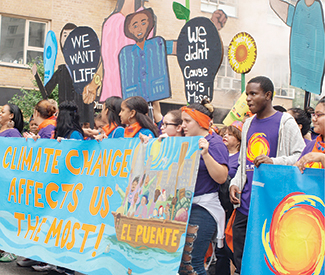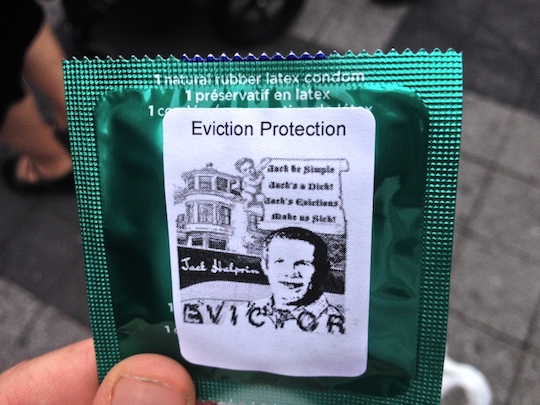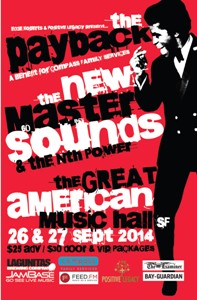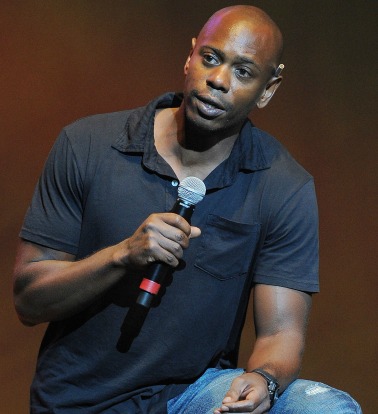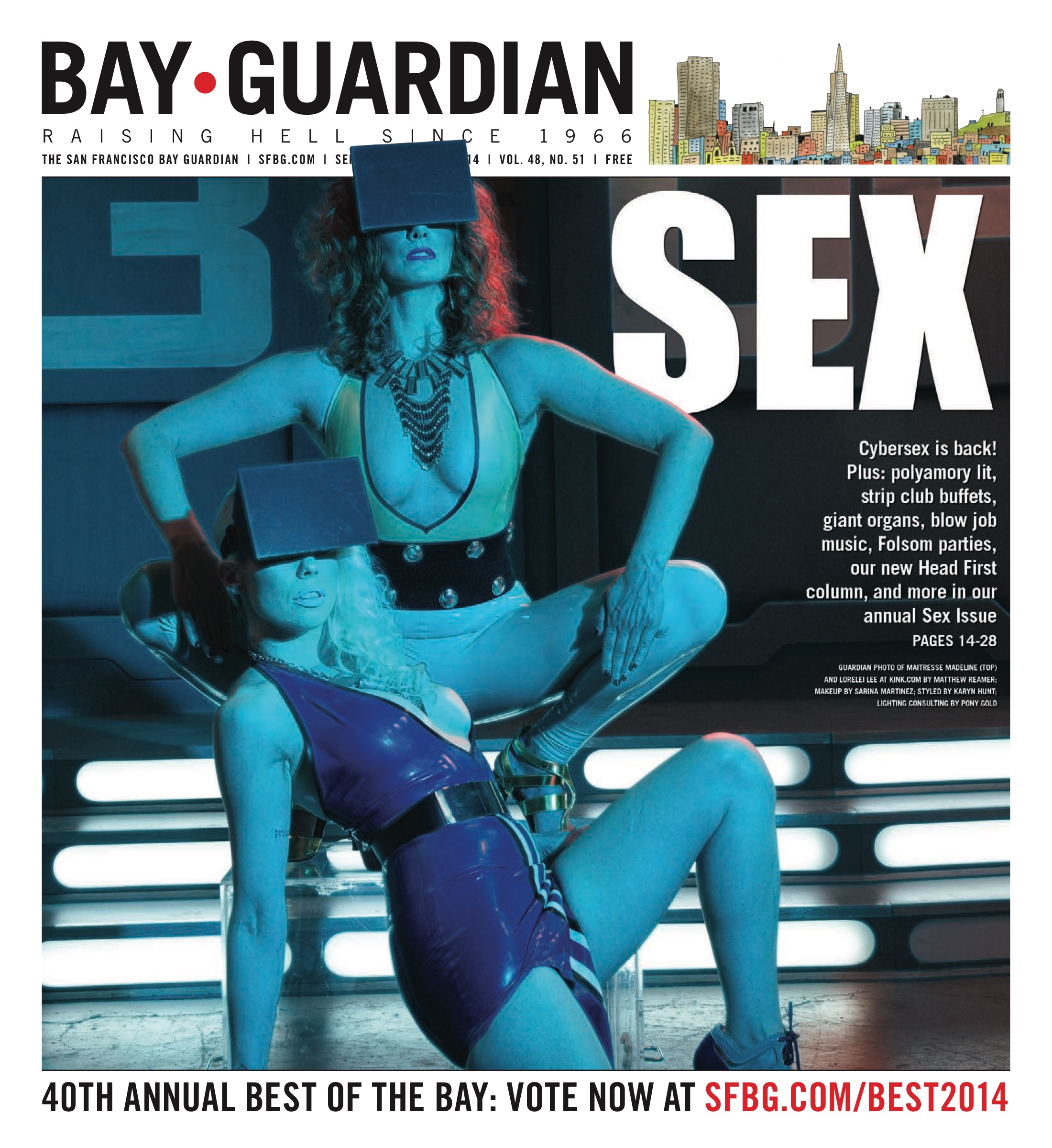news@sfbg.com
In New York City’s Times Square on a muggy, gray Sunday afternoon at the historic People’s Climate March, everything went silent for a minute as a massive crowd, led by indigenous people from around the world, raised fists in the air to support communities suffering the harshest effects of climate change.
In this canyon of glittering commerce, surrounded by corporate icons such as Chase Bank, Bank of America, Gap, McDonald’s, and Dow Jones, the silent coalition then burst into a thunderous crescendo meant to symbolize action and demand climate justice.
On Sept. 21, a veritable ocean of humanity, estimated at up to half a million people — a diverse global tapestry hailing from South Bronx to South Dakota, Kenya to the Philippines — flooded Manhattan’s streets with calls for climate change action two days before a major United Nations Climate Summit that few expected to produce much, if any, change. The next day [Mon/22], a more confrontational “Flood Wall Street” civil disobedience action drew thousands.
The New York march, part of a worldwide day of action spanning more than 2,700 rallies in 159 countries, represented the largest, loudest sign yet that the world is waking up en masse to the climate crisis. Stretching for miles through Manhattan’s mid-section, wave after wave of contingents illustrated the crisis’ universal effects and broadening response: Indigenous people’s groups from around the world, labor unions, faith and LGBTQ groups, low-income communities of color. More than 1,400 organizations endorsed the march.
The People’s Climate March also reflected the urgency and rising response from communities of color and indigenous people who bear the brunt of climate disasters. As many attested, these climate-hammered communities are bringing economic and ecological justice issues to the forefront of a movement often criticized for being predominantly white.
“I’m here because I have a chronically asthmatic daughter,” said Tanya Fields, a 34-year-old mother of five and executive director of the Bronx-based Black Project. In poor waterfront communities from New York’s Far Rockaway and the Bronx, to New Orleans, “communities are not being prepared for the inevitable repercussions” of climate change, Fields said. “When you look at the intersection of climate change and capitalism, those who are have-nots clearly are much more vulnerable. When we talk about creating a more resilient world, we’re also talking about protecting the most marginalized.”
Iya’falolah Omobola, marching with a Mississippi environmental justice group called Cooperation Jackson, said her community has been hit hard by a confluence of climate change, poverty, and health struggles.
“We have a lot of issues directly related to climate, but also to the fact that there are no jobs, there’s no public transportation to get people to jobs,” she said. “There has to be a community-led solution as opposed to the system that keeps compounding the problem.”
Behind a banner stating, “Climate affects us the most,” 300 or so marched from the Brooklyn-based El Puente Leadership for Peace and Justice, including many youth.
“Many of our young people are from the Dominican Republic and Puerto Rico. We know what’s happening to our people there in terms of climate change, so we’re coming together,” said El Puente Executive Director Frances Lucerna. “The connection between what happened here when Hurricane Sandy hit and what’s happening in our islands, in terms of beach erosion and extinction of species, is devastating.”
Marchers from Africa, Latin America, South Asia, and beyond highlighted the underlying “first world” causes behind the climate crisis. Marifel Macalanda, of the Asian Pacific Indigenous Youth Network in the Philippines, said she was in New York “in solidarity with indigenous peoples worldwide,” urging corporations to “stop plundering our resources. They are the primary reasons we are having this climate crisis right now.”
Meima Mpoke, who traveled from Kenya along with 20 of his compatriots, added, “We are here to say to the industrialized world, you are the cause of this.” The UN Summit, Mpoke said, “should produce some action, particularly to show who is causing the climate change.”
Marching with a large Bronx contingent of Percent for Green, Alicia Grullon emphasized similar struggles in poor US communities. The South Bronx is “a dumping ground” for New York’s toxins, and “the asthma capital of the country,” she said. The UN summit presented “an unusual gift for policymakers to do something new … and we’re afraid they’re not going to do that and we’re here to remind them of that great opportunity they have.” However, she added, the Summit gave corporations a big seat at the table: “That’s not representing needs of the people.”
Mychal Johnson, co-founder of South Bronx Unite, was one of just 38 civil society representatives invited to attend the UN Summit. “I won’t have a speaking role,” he said, but “our presence hopefully will speak volumes.” The gulf between the massive public march and the closed-doors UN summit was “a grave contrast,” Johnson said. “A great deal of corporations have been invited, but for so long, the voices of the many have not been heard. We know what corporations are doing to cause harm to the planet, and hopefully this [march] will show people coming together all over world to make sure that legally binding agreements come out of these climate talks.”
DIM HOPES FOR UN SUMMIT
Billing itself as “catalyzing action,” Tuesday’s UN Climate Summit issued bold pronouncements ahead of its proceedings — but social justice groups from around the world were not buying it.
“The Climate Summit will be about action and solutions that are focused on accelerating progress in areas that can significantly contribute to reducing emissions and strengthening resilience,” the Summit website promoted. “Eradicating poverty and restructuring the global economy to hold global temperature rise below 2 degrees Celsius are goals that — acted on together — can provide prosperity and security for this and future generations.”
But critics blasted the UN climate agenda for emphasizing voluntary reforms and “partnerships” with businesses and industries that are fundamentally part of the problem. One week before the People’s Climate March, global social movements including La Via Campesina, Grassroots Global Justice Alliance, and Indigenous Environmental Network — representing a total of more than 200 million people — issued a statement decrying the “corporate takeover of the UN and the climate negotiations process,” Common Dreams reported.
“The Summit has been surrounded by a lot of fanfare but proposes voluntary pledges for emissions cuts, market-based and destructive public-private partnership initiatives such as REDD+, Climate-Smart Agriculture and the Sustainable Energy for All Initiative,” according to the statement. “These are all false solutions of the green economy that seeks to further commodify life and nature and further capitalist profit.”
BIGGER TENT, SMALLER MESSAGE?
Despite concerns about the Summit, the People’s Climate March drew criticism from some activists for not making any demands, and for spending big on public relations while opting for a nonconfrontational “big tent” that some said diluted the movement’s message and impact.
A “Flood Wall Street” direct action Monday drew thousands for civil disobedience, issuing a strong message: “Stop Capitalism. End the Climate Crisis. Flood, blockade, sit-in, and shut down the institutions that are profiting from the climate crisis,” the event’s website urged. “After the People’s Climate March, wearing blue, we will bring the crisis to its cause with a mass sit-in at the heart of capital.”
Flood Wall Street’s more confrontational approach and its naming of capital illustrates unresolved differences about where the movement should focus its energy: Will it work for market reforms, such as 350.org’s popular fossil fuels divestment campaign, or press for larger systemic change? As it erects a big political tent drawing broad mainstream support, will the climate movement be able or willing to push bold demands that may confront capital and corporate power?
In a widely read critique for Counterpunch, writer Arun Gupta argued that the focus on drawing a big crowd came at the expense of a sharper message and impact. “[W]hen the overriding demand is for numbers, which is about visuals, which is about PR and marketing, everything becomes lowest common denominator. The lack of politics is a political decision.”
In an e-mail comment, Bobby Wengronowitz, who helped organize for the Flood Wall Street actions, said he supported the big march, but added, “We need to match the scale of the crisis. We need to get the US and other rich countries on a 10 percent emissions reductions per year plan. That requires white privileged folks to do what indigenous people have been doing for 500 years — to put their bodies on the line … I’m all for big tent, but this march, even if the final tally is 500K does NOT do it.”
A three-day Climate Convergence, featuring talks, films, and teach-ins, offered protesters a dose of critical thinking, urging, “Demand an end to fossil fuels, mobilize for system change, living wage jobs now!” At an event on climate change and the public sector, a panel of organizers and authors raised questions about the focus on market-driven approaches, discussing the potential for addressing climate change through a revitalized public sector.
NEW COALITIONS AND HOPE
On the day of the big march, the sheer immensity of the gathering and the expressions of hope were palpable.
“Today I marched peacefully alongside humans of all class and race, of all gender and sexuality, among anarchist, indigenous, labor unions, different political parties and so many more,” said Patrick Collins, who rode the People’s Climate Train from San Francisco. “[S]eeing the over 1,000 different groups come together in the march who all have different ideologies but are willing to look past differences and agree on common ground does give me some sort of hope.”
Many marchers also expressed hope for new coalitions to pack a potent punch in the fight for climate justice. Labor unions were out in force — teachers, nurses, janitors, food workers, and farmworkers — marching for economic justice, green jobs, and more.
Erin Carrera, a registered nurse and member of National Nurses United, said it was “a monumental moment to be here today with all these labor organizations, because labor and environmentalists have not always been on same page—but I think everyone’s coming to realize that there are no jobs on a dead planet.” Organized labor, Carrera said, “needs skin in the game, because it’s the working class that’s going to be most vulnerable … today gives me so much hope that we have turned a corner in people waking up and working together.”
Aboard the People’s Climate Train
As our cross-country People’s Climate Train passed through Azure, Colo., above a stunning crimson and white rock gorge under a deep-blue sky, James Blakely delivered a presentation on the ecological crisis in the Alberta Tar Sands. Blakely, an activist with 350.org in Idaho, described toxic tailing ponds filled with mining refuse, polluted waterways, dust clouds, and buffalo die-offs. Aboard the train, one of two ferrying hundreds from California to New York’s mass mobilization, our group — ranging in age from 19 to 68 — alternated between snapping photos of the awe-inspiring beauty outside, to probing conversations about rescuing our imperiled planet. Through the Amtrak window, California’s drought-withered cornfields stood wilted and barren, skeleton-like. In the Sierras, forest fires blurred the horizon with smoky haze. Late at night in the Nevada desert, huge factories and refineries churned away. Coal trains traversed the land, spewing fossil fuels. There were reminders of beauty, too. At about 5am, my sleepless eyes took in an ethereal pre-dawn scene. Gnarled sandstone rock formations rose near the tracks in Utah like moon faces; followed by a salmon-hued sunrise splashing across mesas tufted with sage and juniper. Liz Lamar, an activist with the Sierra Club and the Climate Reality Project in Oxnard said the cross-country passage made her “even more passionate about going on the march, by passing through such beautiful scenery.” The People’s Climate Train provided an apt backdrop for workshops and conversations about the causes and victims of climate crisis, and the prodigious challenges ahead. Sonny Lawrence Alea, a recent environmental studies graduate from San Francisco State University, said the ride offered “a great reminder of what we’re going to New York for. This land is full of opportunities, and we get to connect with the environment, take in the beauty, and reflect on the history of the land.” (Christopher D. Cook)

